Serving 528 students in grades 9-12, Harrisburg High School ranks in the bottom 50% of all schools in Illinois for overall test scores (math proficiency is bottom 50%, and reading proficiency is bottom 50%).
The percentage of students achieving proficiency in math is ≤5% (which is lower than the Illinois state average of 28%). The percentage of students achieving proficiency in reading/language arts is 15-19% (which is lower than the Illinois state average of 30%).
The student:teacher ratio of 12:1 is lower than the Illinois state level of 13:1.
Minority enrollment is 20% of the student body (majority Black and Hispanic), which is lower than the Illinois state average of 55% (majority Hispanic).
Quick Stats (2025)
- Grades: 9-12
- Enrollment: 528 students
- Student:Teacher Ratio: 12:1
- Minority Enrollment: 20%
- Graduation Rate: 75-79% (Btm 50% in IL)
- Overall Testing Rank: Bottom 50%
- Math Proficiency: ≤5% (Btm 50%)
- Reading Proficiency: 15-19% (Btm 50%)
- Science Proficiency: 40-44% (Btm 50%)
- Source: National Center for Education Statistics (NCES), IL Dept. of Education
School Overview
Harrisburg High School's student population of 528 students has stayed relatively flat over five school years.
The teacher population of 43 teachers has grown by 22% over five school years.
Grades Offered
Grades 9-12
Total Students
528 students
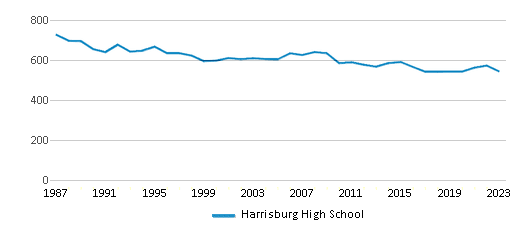
Gender %
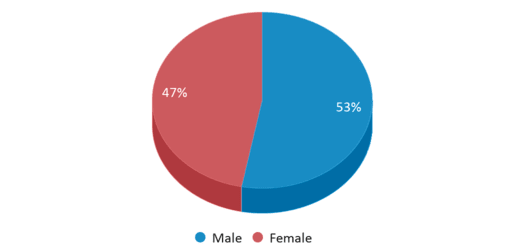
Total Classroom Teachers
43 teachers
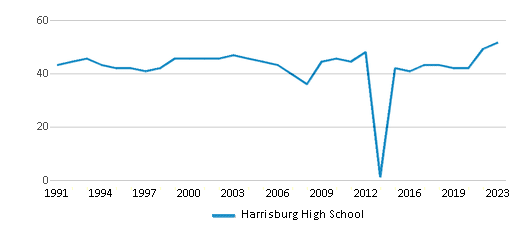
Students by Grade
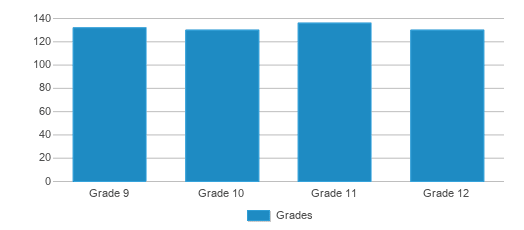
School Calendar
School Rankings
Harrisburg High School ranks within the bottom 50% of all 3,426 schools in Illinois (based off of combined math and reading proficiency testing data).
The diversity score of Harrisburg High School is 0.35, which is less than the diversity score at state average of 0.70. The school's diversity has stayed relatively flat over five school years.
Overall Testing Rank
#2749 out of 3426 schools
(Bottom 50%)
(Bottom 50%)
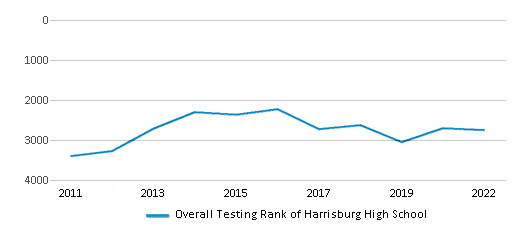
Math Test Scores (% Proficient)
(20-21)≤5%
28%
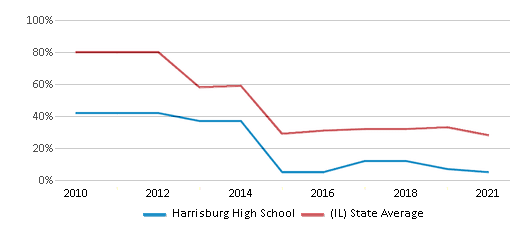
Reading/Language Arts Test Scores (% Proficient)
15-19%
30%
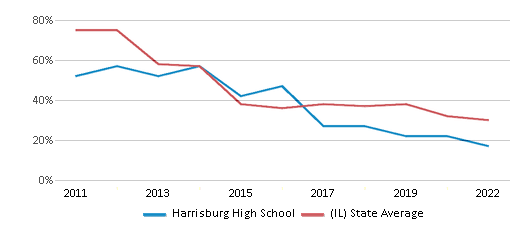
Science Test Scores (% Proficient)
40-44%
50%
Student : Teacher Ratio
12:1
13:1
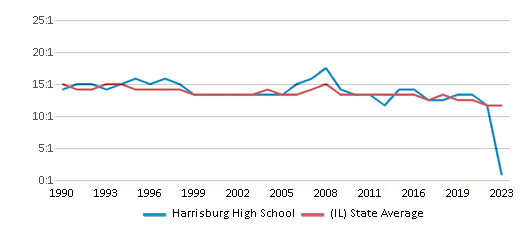
American Indian
n/a
1%
Asian
1%
6%

Hispanic
5%
28%

Black
5%
16%
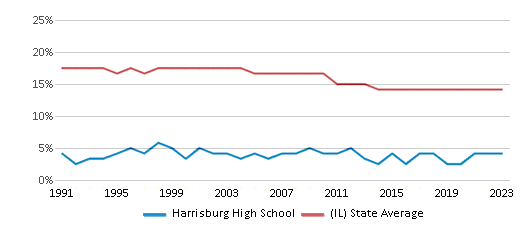
White
80%
45%
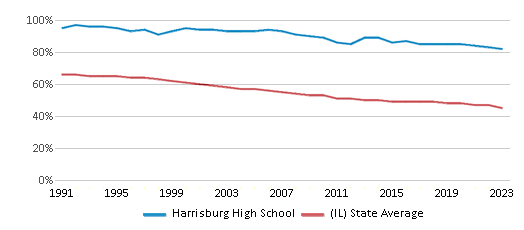
Hawaiian
n/a
n/a
Two or more races
9%
4%
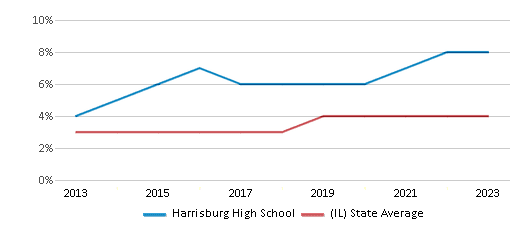
All Ethnic Groups
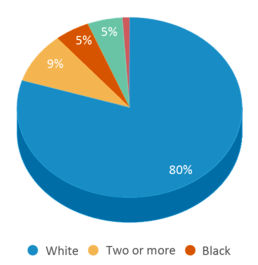
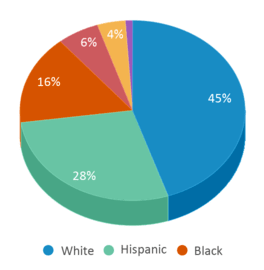
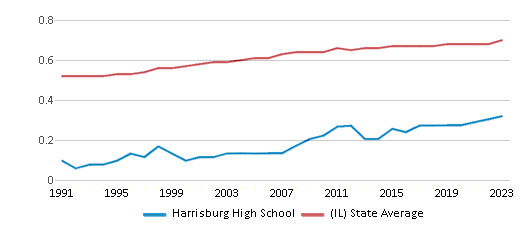
Graduation Rate
75-79%
87%
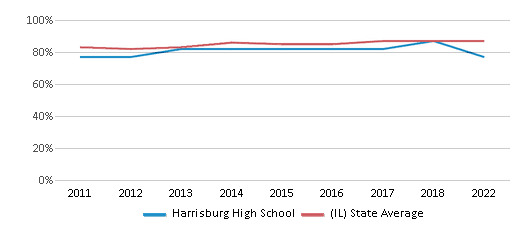
Eligible for Free Lunch
44%
43%
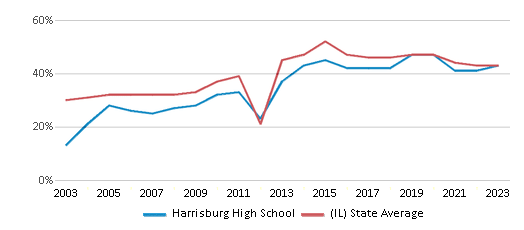
Eligible for Reduced Lunch
15%
4%
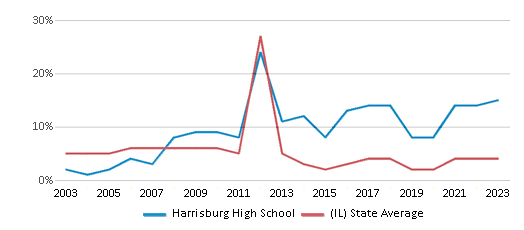
School Statewide Testing
School District Name
Source: National Center for Education Statistics (NCES), IL Dept. of Education
Profile last updated: 02/09/2025
Frequently Asked Questions
What is Harrisburg High School's ranking?
Harrisburg High School is ranked #2749 out of 3,426 schools, which ranks it among the bottom 50% of public schools in Illinois.
What schools are Harrisburg High School often compared to?
Harrisburg High Schoolis often viewed alongside schools like Eldorado High School, Pope Co High School, Vienna High School by visitors of our site.
What percent of students have achieved state testing proficiency in math and reading?
≤5% of students have achieved math proficiency (compared to the 28% IL state average), while 15-19% of students have achieved reading proficiency (compared to the 30% IL state average).
What is the graduation rate of Harrisburg High School?
The graduation rate of Harrisburg High School is 75-79%, which is lower than the Illinois state average of 87%.
How many students attend Harrisburg High School?
528 students attend Harrisburg High School.
What is the racial composition of the student body?
80% of Harrisburg High School students are White, 9% of students are Two or more races, 5% of students are Black, 5% of students are Hispanic, and 1% of students are Asian.
What is the student:teacher ratio of Harrisburg High School?
Harrisburg High School has a student ration of 12:1, which is lower than the Illinois state average of 13:1.
What grades does Harrisburg High School offer ?
Harrisburg High School offers enrollment in grades 9-12
What school district is Harrisburg High School part of?
Harrisburg High School is part of Harrisburg CUSD 3 School District.
School Reviews
2 10/5/2009
The academic programs at this school are terrible, almost pathetic. The majority of the teachers are employed because they all know one another and/or went to school there themselves, not because they are qualified to teach. Only a select few teachers actually take their jobs seriously, and try to educate the students who attend. The school does offer extracurricular activities, but most have to be funded by the activity coordinator and participants, because all of the funding the school receives for activities go directly to the sports - particularly football and basketball. The state testing scores are quite low and this school has a very high drop-out rate. Student violence, foul language, and bad attitude are also high at this school. Fights occur very often, and most of the time no parents or officials are notified. Many more things can be said about this school but I will leave it at this. Thank you.
Review Harrisburg High School. Reviews should be a few sentences in length. Please include any comments on:
- Quality of academic programs, teachers, and facilities
- Availability of music, art, sports and other extracurricular activities
Recent Articles

What Is A Charter School?
Explore the world of charter schools in this comprehensive guide. Learn about their history, how they operate, and the pros and cons of this educational innovation. Discover key facts about charter schools, including admission policies, demographics, and funding, as well as what to look for when considering a charter school for your child.

10 Reasons Why High School Sports Benefit Students
Discover the 10 compelling reasons why high school sports are beneficial for students. This comprehensive article explores how athletics enhance academic performance, foster personal growth, and develop crucial life skills. From improved fitness and time management to leadership development and community representation, learn why participating in high school sports can be a game-changer for students' overall success and well-being.

February 05, 2025
Understanding the U.S. Department of Education: Structure, Impact, and EvolutionWe explore how the Department of Education shapes American education, from its cabinet-level leadership to its impact on millions of students, written for general audiences seeking clarity on this vital institution.





